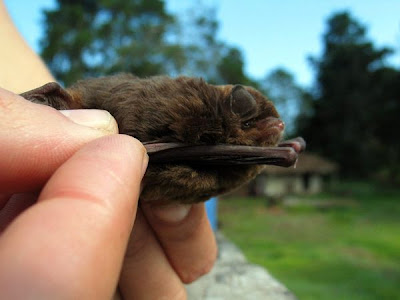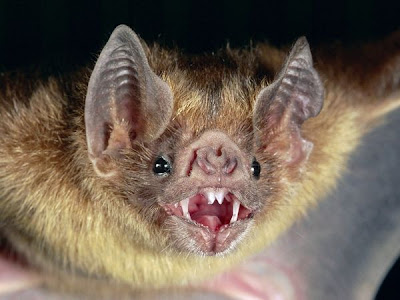Rare African Bats, Rare Types of Bats Photos & Pictures of Bats
 ( Rare African Bats ) Rhinolophus Clivosus - This is a larger species than both Rhinolophus blasii and Rhinolophus simulator. Generally widespread and common, this species is a generalist feeding in more open areas and wooded savannas. There are many recognized subspecies across its range, and it is likely that some of these represent distinct species.
( Rare African Bats ) Rhinolophus Clivosus - This is a larger species than both Rhinolophus blasii and Rhinolophus simulator. Generally widespread and common, this species is a generalist feeding in more open areas and wooded savannas. There are many recognized subspecies across its range, and it is likely that some of these represent distinct species. ( Rare African Bats ) Rhinolophus Simulator : This is a another Rhinolophus simulator captured in lowland forest. This shares the same coloration as the other.
( Rare African Bats ) Rhinolophus Simulator : This is a another Rhinolophus simulator captured in lowland forest. This shares the same coloration as the other. ( Rare African Bats ) Rhinolophus Simulator : This is another species of horseshoe bat called Rhinolophus simulator. Although very similar in size and general appearance to R. blasii, the horseshoe (nasal) structure differs and it calls at a completely different echolocation frequency. Interestingly, we observed that on Mount Mulanje, one species was common, while the other was rare; whereas in lowland forests, it was the other way around. This may be due to competition for feeding niches, roosting sites, or differences in life history traits. Although this individual is colored a rusty orange, there is a separate form of the same species that is a dull brown.
( Rare African Bats ) Rhinolophus Simulator : This is another species of horseshoe bat called Rhinolophus simulator. Although very similar in size and general appearance to R. blasii, the horseshoe (nasal) structure differs and it calls at a completely different echolocation frequency. Interestingly, we observed that on Mount Mulanje, one species was common, while the other was rare; whereas in lowland forests, it was the other way around. This may be due to competition for feeding niches, roosting sites, or differences in life history traits. Although this individual is colored a rusty orange, there is a separate form of the same species that is a dull brown. ( Rare African Bats ) Miniopterus : This is a species of the genus Miniopterus, (long-fingered bats). A molecular study (including samples from our work) is showing that this particular family of bats appears to have endemic species to almost all the major mountain ranges of Africa. And yet they are almost indistinguishable based on external appearance. This represents such a large degree of "cryptic" diversity that one prominent researcher described the family as Africa's "cichlid fish of the skies."
( Rare African Bats ) Miniopterus : This is a species of the genus Miniopterus, (long-fingered bats). A molecular study (including samples from our work) is showing that this particular family of bats appears to have endemic species to almost all the major mountain ranges of Africa. And yet they are almost indistinguishable based on external appearance. This represents such a large degree of "cryptic" diversity that one prominent researcher described the family as Africa's "cichlid fish of the skies." ( Rare African Bats ) Miniopterus : This is another species of the genus Miniopterus (long-fingered bats). This is a separate species to the darker Miniopterus shown previously, and the form is generally larger, with lighter fur.
( Rare African Bats ) Miniopterus : This is another species of the genus Miniopterus (long-fingered bats). This is a separate species to the darker Miniopterus shown previously, and the form is generally larger, with lighter fur. ( Rare African Bats ) Kerivoula Lanosa : This is a fully grown woolly bat, Kerivoula lanosa. Weighing only 4 to 5 grams, they are specialists in dense forest environments. In Australia, members of this genus were found to be feeding almost exclusively on spiders that are gleaned from webs hanging over small forest paths or between the foliage. The common name of the genus refers to their elegant fur, which in this species is grizzled with long white hairs.
( Rare African Bats ) Kerivoula Lanosa : This is a fully grown woolly bat, Kerivoula lanosa. Weighing only 4 to 5 grams, they are specialists in dense forest environments. In Australia, members of this genus were found to be feeding almost exclusively on spiders that are gleaned from webs hanging over small forest paths or between the foliage. The common name of the genus refers to their elegant fur, which in this species is grizzled with long white hairs. ( Rare African Bats ) Rhinolophus Blasii : This is one of the last captures from a busy night sampling near a hydroelectric dam in the heart of a forested gorge on Mount Mulanje in Malawi. This species of horseshoe bat, Rhinolophus blasii, was very common, making up roughly 70 percent of all the individuals that we captured in and around this site.
( Rare African Bats ) Rhinolophus Blasii : This is one of the last captures from a busy night sampling near a hydroelectric dam in the heart of a forested gorge on Mount Mulanje in Malawi. This species of horseshoe bat, Rhinolophus blasii, was very common, making up roughly 70 percent of all the individuals that we captured in and around this site. ( Rare African Bats ) Miniopterus : This is a third species of the genus Miniopterus. While a similar size to the first, the skull length is slightly greater and the pelage is a rich dark brown, rather than dark grey. We captured this individual while sampling the standing forests of Mulanje cedar, an endemic tree that acts as the emblem and namesake of this mountain. Unfortunately, the tree is on the verge of extinction as illegal logging of the timber continues and a planned bauxite mining project will see large tracts of remaining forest destroyed.
( Rare African Bats ) Miniopterus : This is a third species of the genus Miniopterus. While a similar size to the first, the skull length is slightly greater and the pelage is a rich dark brown, rather than dark grey. We captured this individual while sampling the standing forests of Mulanje cedar, an endemic tree that acts as the emblem and namesake of this mountain. Unfortunately, the tree is on the verge of extinction as illegal logging of the timber continues and a planned bauxite mining project will see large tracts of remaining forest destroyed. Rare African Bats Picture - Rhinolophus Blasii Photo
Rare African Bats Picture - Rhinolophus Blasii Photo ( Rare African Bats )Myotis Welwitschii : This is a very rare species called Myotis welwitschii. Known from only scattered few records across the continent, this catch was a fabulous record. The species is thought to have a paramontane distribution—i.e., it is found associated to, but not restricted to, mountain environments. It is possible that they migrate altitudinally with season. The coloring on the wings is a stark red, pockmarked with black spots and blotches.
( Rare African Bats )Myotis Welwitschii : This is a very rare species called Myotis welwitschii. Known from only scattered few records across the continent, this catch was a fabulous record. The species is thought to have a paramontane distribution—i.e., it is found associated to, but not restricted to, mountain environments. It is possible that they migrate altitudinally with season. The coloring on the wings is a stark red, pockmarked with black spots and blotches. ( Rare African Bats ) Myotis Tricolor : This is Myotis tricolor, a relatively common savanna species that is widespread across Africa. Its name refers to the three colors present on each hair—a dark base leads to a cream-colored middle and terminates in a beautiful rusty orange. The open mouth nicely shows two glands in the cheeks, behind the rows of teeth. In other species, males have been observed marking territorial areas of a cave wall by rubbing these glands against the surface.Comman Vampire Bat
( Rare African Bats ) Myotis Tricolor : This is Myotis tricolor, a relatively common savanna species that is widespread across Africa. Its name refers to the three colors present on each hair—a dark base leads to a cream-colored middle and terminates in a beautiful rusty orange. The open mouth nicely shows two glands in the cheeks, behind the rows of teeth. In other species, males have been observed marking territorial areas of a cave wall by rubbing these glands against the surface.Comman Vampire Bat Vampire Bat PictureUnique amongst mammals, the common vampire bat feeds entirely on blood sucked from its warm-blooded prey.
Vampire Bat PictureUnique amongst mammals, the common vampire bat feeds entirely on blood sucked from its warm-blooded prey.








